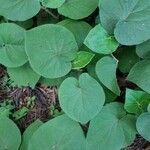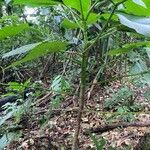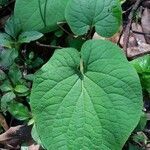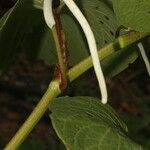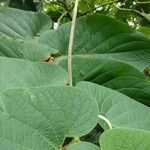A small, soft-wooded, commonly more or less aromatic tree, 3-6 m. tall, often occurring in clumps; flowering internodes moderately slender and long, striate, often drying black, glabrate or sometimes slightly pubescent; leaves ovate, oblong-or elliptic-ovate, 12-20 cm. wide X 20-30 cm. long, or occasionally up to 25 X 40 cm. or more, apex acute or short-acuminate, base deeply cordate with one side 1-2 cm. longer at the petiole and with the lower lobe longer, sinus rounded to the petiole, the midrib with 3 or 4 upcurved branches from below the upper third and 3 or 4 branches from the base, rather thinly short-hairy above at least along the nerves, more densely so beneath, densely white-ciliolate throughout, drying thin, translucent; petiole 4-9 plus 1-2 cm. long, more or less pubescent or glabrate, vaginate-winged to the blade; spikes creamy or light-yellow when dry, 3-5 mm. thick X 10-25 cm. long; peduncle slender, 2-8 cm. long, glabrate, often black when dry; bracts round-or triangular-subpeltate, marginally fringed; fruit small, glabrate, obpyramidal-trigonous; stigmas 3, sessile.
More
Shrubs or subshrubs (rarely herbaceous), reclining, 2-5 m, glabrous. Leaves: petiole 1/6-1/3 length of leaf blade, winged at base. Leaf blade ovate, 20-35×17-20 cm, base narrowly and deeply obliquely cordate, apex abruptly short-acuminate to acute; surfaces abaxially and adaxially minutely pubescent, most conspicuously so along veins. Spikes 12-25 cm. Fruits not seen.
Moist or wet thickets or forest, often in second growth, at elevations up to 1,800 metres, but usually below 900 metres. Often forms dense thickets in abandoned land, partly on account of the great abundance of seeds produced.
